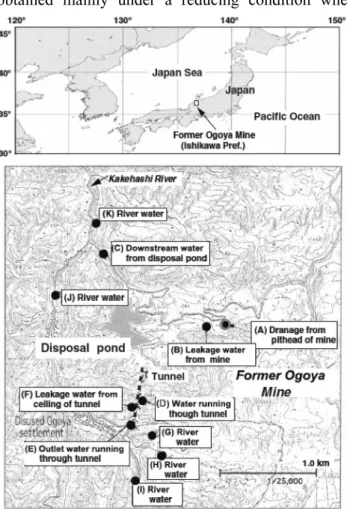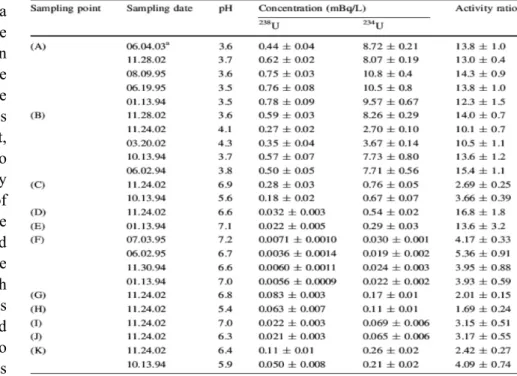- 91 -
Uranium in acidic mine drainage at the former Ogoya Mine in Ishikawa Prefecture of Japan
Masayoshi Yamamoto,1* Aya Sakaguchi,2 Hisaki Kofuji3
1Low Level Radioactivity Laboratory, K-INET, Kanazawa University, Wake, Nomi-shi, Ishikawa 923-1224, Japan.
2Faculty of Science, Hiroshima University, Kagamiyama, Higashi-Hiroshima, Hiroshima 739-8526, Japan
3Japan Marine Science Foundation, Mutsu Marine Laboratory, Mutsu, Aomori 035-0064, Japan
Nowadays, radioactive disequilibrium (i.e., activity ratios among nuclides that are not unity) in the uranium decay series is a quite common and well-investigated phenomenon.The 234U/238U radioactive disequilibrium is still of interest in connection with hot atom phenomena, and the extent of this disequilibrium has been used as a tool in hydrologic investigations such as water circulation, mixing of water masses between various aquifers and geochronology.
We found high 234U/238U activity ratios of around 13 in acidic mine drainage (pH: around 3.5) from the former Ogoya Mine where is ca. 20 km from the LLRL. Generally, anomalous ratios of 234U/238U have been found in neutral water samples obtained mainly under a reducing condition where weathering (dissolution) of aquifer rock is
suppressed. Therefore, the appearance of high 234U/238U activity ratios in water under the acidic condition is a striking feature, because the 234U/238U activity ratio is considered to be near unity if the dissolution of rocks is accelerated under the acidic water condition, which makes a better understanding of the processes controlling high 234U/238U activity ratios scientifically very interesting.
In this paper, we measured uranium isotopes in mine drainage from the former Ogoya Mine in Ishikawa Prefecture, Japan, and in surface waters from its surrounding rivers from the viewpoint of radioactive disequilibrium in the uranium decay series.
Based on the measurements, we discuss probable processes controlling the high
234U/238U activity ratios in acidic drainage from the mine.
The results of the 238U and 234U
concentrations and their 234U/238U activity ratios in water samples are summarized in Table 1. The 238U concentrations in the water samples varied widely from
0.0036-0.78 mBq/L with a factor of about
Fig. 1 Map showing the location of the former Ogoya Mine and water sapling points
- 92 -
200. Higher values were found in the acidic water samples from the pithead (A) and leakage (B).
Mine drainage discharged to the outside environment has been generally divided into three categories from the viewpoint of water quality: (1) acidic water (pH: 3-5) of Ca-SO4 type including a large amount of iron; (2) mildly alkaline water (pH: 8-9) of NaHCO3-SO4 type; and (3) neutral water of Na-SO4 type. The drainage from the Ogoya Mine is probably category (1).
It can be interpreted as given below. Immediately after the drainage flows onto the earth’s surface, its pH is about 5, and it is acidified to pH of 2-3 rapidly on contact with air. Pyrite (FeS2) is dissolved under the reducing condition, and after contact with air, Fe2+ is oxidized to Fe3+, then a brown precipitate of limonite is produced, and then the water is acidified strongly by the oxidation of S to SO42-
. By taking into account this interpretation, underground water in deeper layer of mine drainage seems likely to be neutral and under reducing condition. The acidic water may be limited only in the upper part of the water
in the pits. If the underground water in a deep layer is made acidic, Th isotopes in rocks are expected to be dissolved to some extent, although this is speculative. In fact, although we tried to detect Th isotopes by using water samples of 170 L from the mine pithead, the detected concentrations were very low. The 234Th concentration, which is expected to be ejected directly by recoil due to the a-decay of 238U, was a similar level to that of
238U. The respective concentrations of 230Th, a daughter nuclide of 234U, and 232Th were100 times lower than that of its parent nuclide 234U, and one order of magnitude lower than that of 238U, respectively, although the activities of 232Th in rocks sampled around here were nearly the same as those of 238U. Thus, the existence of excess 234Th relative to 238U could not be observed and Th dissolution was found to be very low compared with U, indicating that deeper water of the pits was unlikely to be under the acidic condition. Under the neutral condition, Th hydrolyses very easily and is rapidly adsorbed by the surface of surrounding mineral particles. High 234U concentration may be attributed to the preferential leaching of 234U produced mainly from such 234Th adsorbed on the surface of the mineral particles. It seems to be reasonable to assume that the acidic water flowing from the mine pithead is from only the upper layer of the pits, and its high 234U/238U ratio is attributable to the deeper underground water under the neutral and reducing conditions.
Table 1 Uranium isotopes and their activity ratios in water samples

